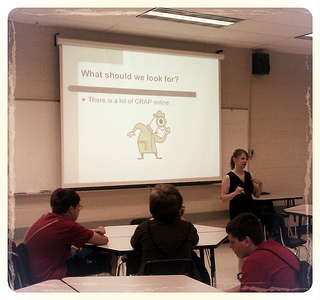Model Digital-Age Work and Learning
Teachers exhibit knowledge, skills, and work processes representative of an innovative professional in a global and digital society.
a. demonstrate fluency in technology systems and the transfer of current knowledge to new technologies and situations.
There two things every traditional reading teacher needs to run a Reader’s Workshop — chart paper, and a library card catalogue system. However, as I progressed in my comfort with and understanding of technology in my classroom I was able to replace both of these items with my SmartPhone – a huge time and cost savings.
One of the most profound transformations of process using technology that I have implemented over the past year is a transition from spiral-bound paper Reading Notebooks to a completely digital Reading Notebook system. Having online digital notebooks has completely changed the way I conference and communicate with my reading students.
b. collaborate with students, peers, parents, and community members using digital tools and resources to support student success and innovation.
I found out this summer that my school would be going 1-1 with iPads in the 2012-2013 school year. Once I got this news I immediately went to the best resource I know, my peers online. I knew they could support me as tried to build a successful iPad rollout plan for my students. I posted questions about iPads in the middle school classroom to my blog, and immediately got some wonderful answers to help me prepare.
As it got closer to rollout time, I collaborated with colleagues to provide resources for students to help explain expected norms and procedures for using iPads in the classroom to make the transition easy and successful.
c. communicate relevant information and ideas effectively to students, parents, and peers using a variety of digital age media and formats.
My main method of providing relevant information to students and parents is my class blog, which has a page with my contact information and also a page containing my weekly lesson plans.
To communicate ideas to my peers, I have a separate blog called Love::Teaching where I post anything I feel is a relevant conversation starter for educators, especially those who might share interests with me: educational technology, teaching reading and writing, and middle school. The “about” page on my blog sums it up:
In the summer of 2011 I was challenged by a presenter at EdCamp SJSD, Dean Shareski, to share my teaching experiences with the world via technology. He said that today’s educators have not only the opportunity, but the responsibility to share with their colleagues worldwide.
I’m easily excited by a new idea to make my classroom better, and I love to share when my students and I do something that works well. I use my blog to share a mix of reflections, lesson ideas, and the just plain love story of my life in education.
d. model and facilitate effective use of current and emerging digital tools to locate, analyze, evaluate, and use information resources to support research and learning.

I collaborate with my building’s teacher librarian to teach our students about internet source reliability and evaluating web sites. We teach them to put sites through the CRAP test – Copyright, Resources, Author, Purpose.
I have also removed all paper dictionaries and thesauruses from my classroom, and instead teach my students the 21st century information resource skills to answer their learning questions.


